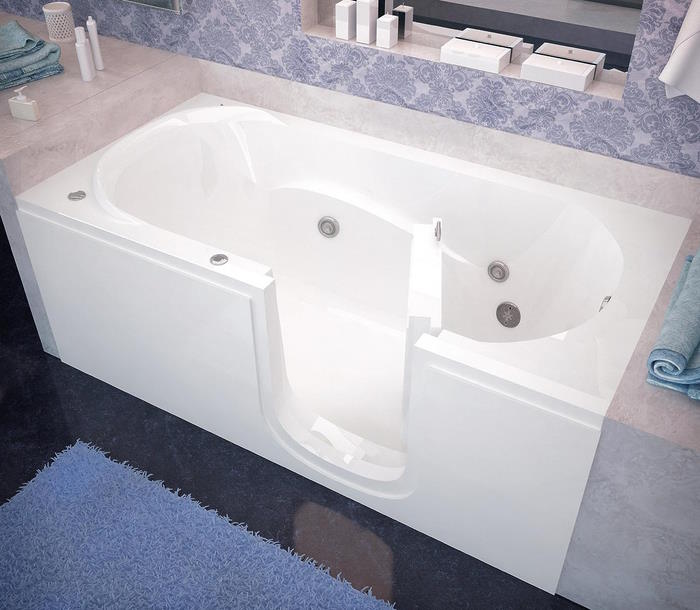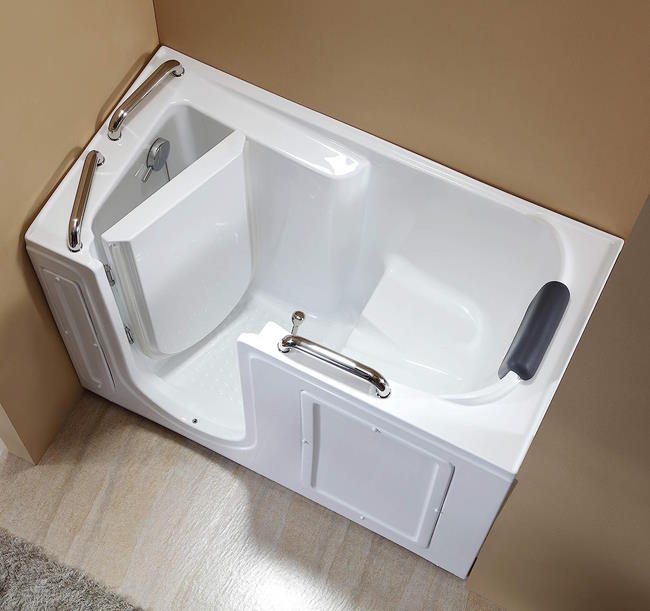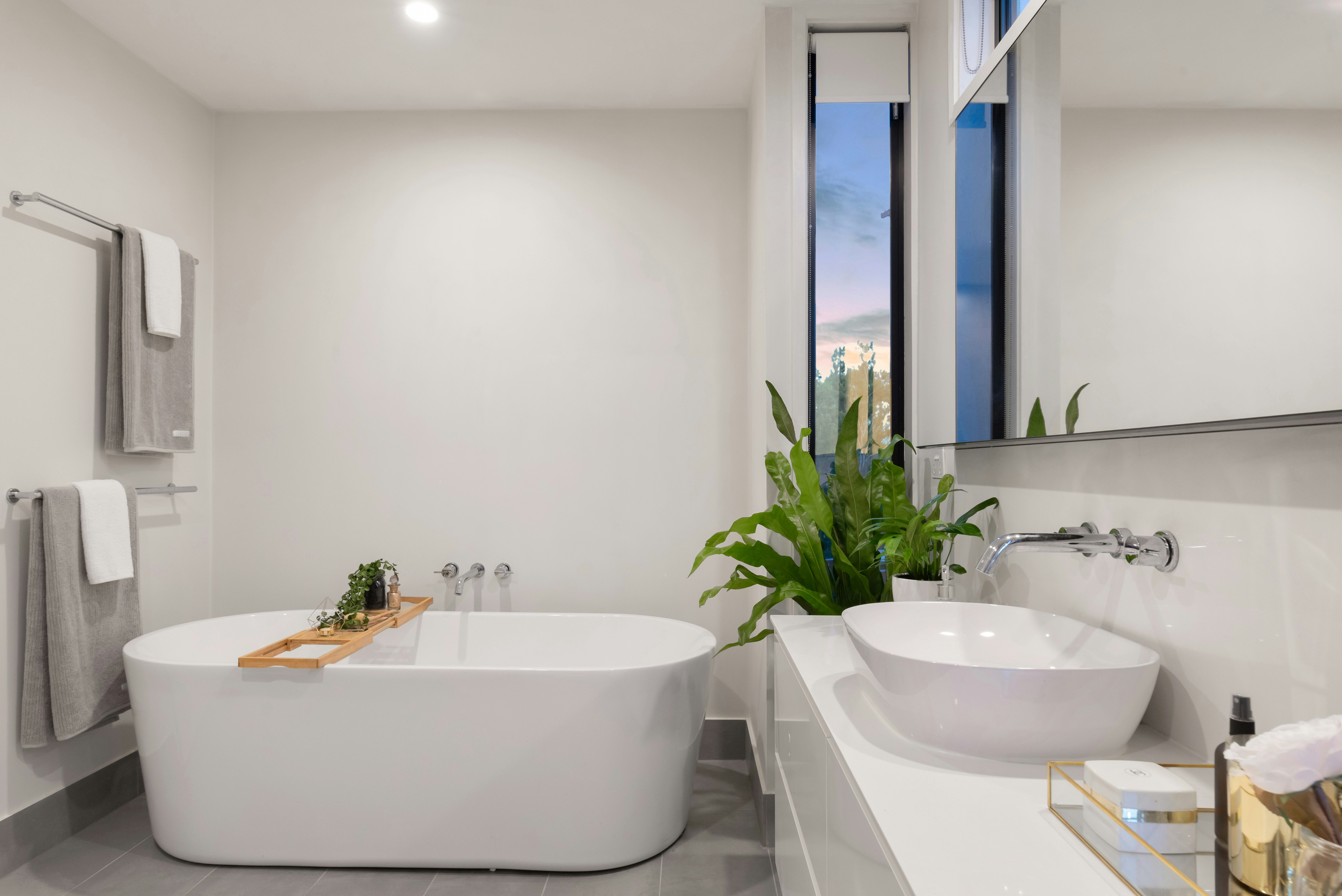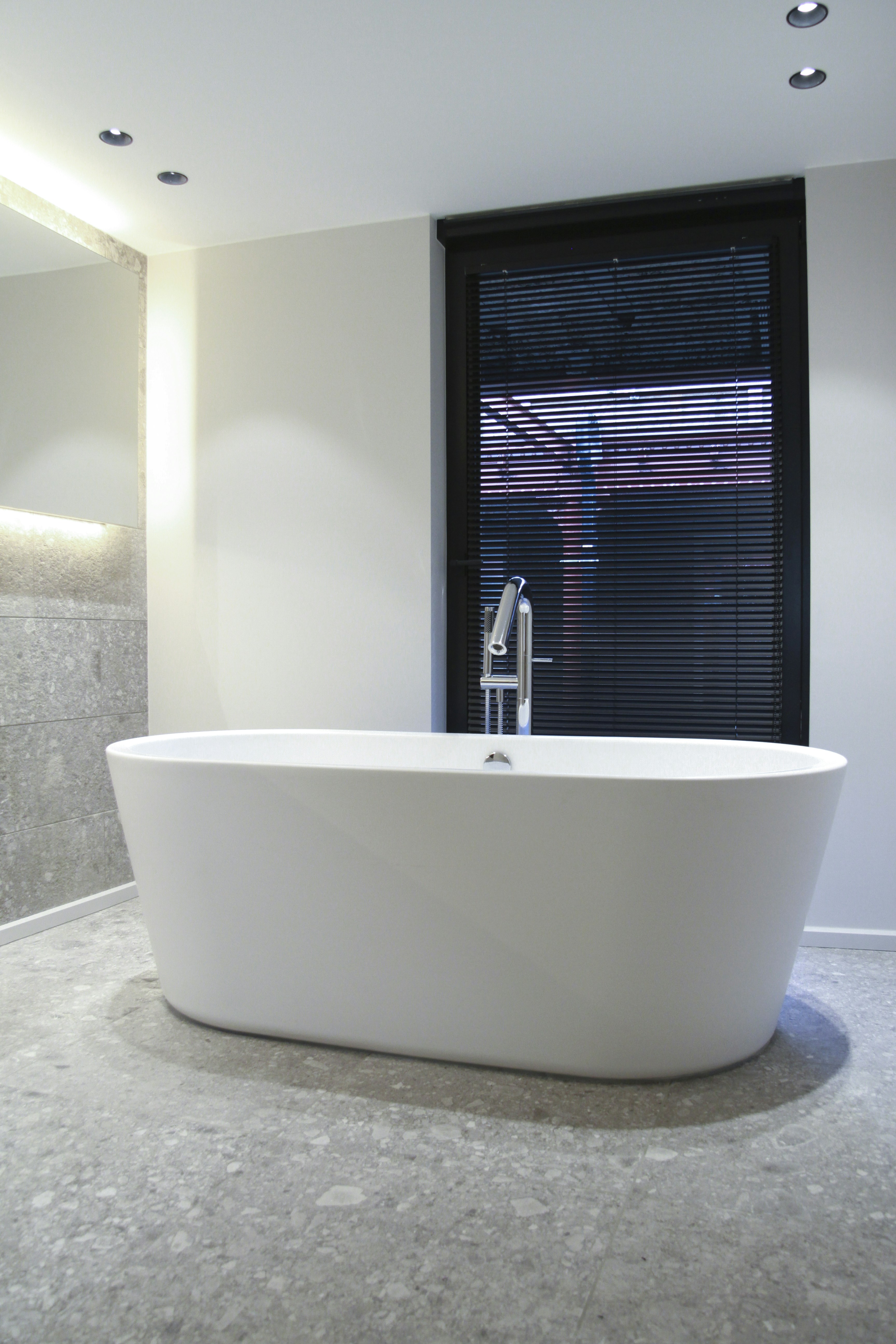Are you in the market for a new bathtub but feeling overwhelmed by the numerous options available? Look no further! Our article, “Walk-In Tubs vs. Traditional Tubs, Choosing Your Tub: Comparing Walk-In and Traditional Bathtubs for Modern Homes,” is here to help you make an informed decision. We will explore the differences between walk-in tubs and traditional tubs, allowing you to choose the perfect option for your modern home. So sit back, relax, and let us guide you through this exciting journey of finding your dream tub!
Overview of Walk-In Tubs
A walk-in tub is a bathtub that is specifically designed to provide easy access and enhanced safety for individuals with limited mobility. It features a watertight door that opens and closes, allowing the user to enter and exit the tub without having to climb over the high sides of a traditional tub. Walk-in tubs are equipped with various safety features such as grab bars, non-slip flooring, and built-in seats to ensure a secure bathing experience.
Features and Design
Walk-in tubs are designed with comfort and safety in mind. They often feature built-in seats that allow individuals to sit comfortably while bathing. This enables them to relax and enjoy their bathing experience without the fear of slipping or falling. Additionally, walk-in tubs may have contoured seating to provide additional comfort and support. These tubs also come equipped with safety features like non-slip flooring, grab bars, and easy-to-reach controls.
Benefits of Walk-In Tubs
Walk-in tubs offer numerous benefits for individuals with limited mobility or those who are elderly. Firstly, they provide a safe and accessible bathing solution, minimizing the risk of accidents and falls. The built-in safety features ensure stability and support, giving peace of mind to both users and their caregivers. Moreover, walk-in tubs often have therapeutic features such as hydrotherapy options, which can help alleviate muscle soreness and joint pain.
Considerations for Installation
Before purchasing a walk-in tub, it’s important to consider the installation requirements. Walk-in tubs may require modifications to your bathroom, such as widening the doorway, or electrical and plumbing adjustments. Professional installation is recommended to ensure proper fitting and functionality. It’s also necessary to evaluate the available space in your bathroom to ensure the tub fits comfortably without compromising accessibility.
Overview of Traditional Tubs
Traditional tubs, also known as standard or conventional tubs, are the more common type of bathtub found in households. These tubs typically have high sides, which require users to step over them when entering and exiting. While they may lack some of the safety features found in walk-in tubs, traditional tubs can still provide a relaxing and enjoyable bathing experience.
Features and Design
Traditional tubs come in a variety of styles and materials, including cast iron, acrylic, and fiberglass. They can be freestanding, built-in, or surrounded by a shower enclosure. Since they don’t have a built-in door or specialized safety features, traditional tubs often offer more design flexibility and options for customization. They can be fitted with various fixtures, such as handheld showerheads and faucets.
Benefits of Traditional Tubs
Despite the lack of specific safety features, traditional tubs have their own unique benefits. They are usually more affordable compared to walk-in tubs and offer a wider range of design options to match different bathroom aesthetics. Traditional tubs also come in various sizes, allowing homeowners to choose one that fits their bathroom layout perfectly. For individuals with no mobility issues, traditional tubs provide a standard bathing experience with the option to incorporate additional amenities like whirlpool jets.
Considerations for Installation
Installing a traditional tub requires careful planning and consideration of the bathroom layout. You need to ensure that the tub can be easily fitted into the space and that the necessary plumbing and drainage connections are in place. Additionally, accessibility for elderly or individuals with limited mobility should be taken into account. Grab bars and non-slip flooring can be installed to enhance safety and prevent accidents, especially for those who may struggle with climbing over the high sides of a traditional tub.
Safety and Accessibility
Safety Features in Walk-In Tubs
Walk-in tubs are designed with safety as a top priority. The tubs typically have non-slip flooring to prevent slipping and falling. Grab bars are strategically placed within easy reach to provide support and stability while getting in and out of the tub. The doors of walk-in tubs are also designed to create a watertight seal when closed, minimizing the risk of water leakage and potential accidents. Additionally, some walk-in tubs are equipped with anti-scald valves to prevent water temperatures from reaching dangerous levels.
Safety Features in Traditional Tubs
While traditional tubs may not have specialized safety features, there are measures that can be taken to enhance safety. Installing grab bars near the tub area can provide additional support when entering and exiting the tub. Non-slip mats or adhesive strips can also be placed on the floor of the tub to reduce the risk of slipping. It’s important to ensure that the bathroom flooring is slip-resistant to prevent accidents. Additionally, having proper lighting in the bathroom can help improve visibility and prevent accidents.
Accessibility for Individuals with Limited Mobility
Walk-in tubs are specifically designed to make bathing more accessible for individuals with limited mobility. The low step-in threshold and wide opening door allow individuals to enter and exit the tub with ease, eliminating the need for climbing over high bathtub sides. The built-in seats provide comfort and stability during bathing. For individuals who use mobility aids like wheelchairs or walkers, some walk-in tubs offer outward-opening doors which enable easy transfer from the mobility device to the seat. These accessibility features promote independence and a higher level of safety for individuals with limited mobility.
Preventing Slip and Fall Accidents
Slip and fall accidents are a common concern in the bathroom, especially for individuals with limited mobility. Both walk-in tubs and traditional tubs can take steps to prevent such accidents. In walk-in tubs, non-slip flooring and grab bars play a crucial role in preventing falls. It is important to ensure that the non-slip flooring is regularly cleaned to maintain its effectiveness. In traditional tubs, the use of non-slip mats or adhesive strips can greatly reduce the risk of slipping. Placing grab bars near the tub area and ensuring good bathroom lighting are additional safety measures that can be taken to prevent accidents.
Comfort and Convenience
Contoured Seating in Walk-In Tubs
Walk-in tubs are designed to provide maximum comfort to users. Many walk-in tubs feature contoured seating, which conforms to the body’s natural curves, providing excellent support and comfort while bathing. This ergonomic design ensures a relaxing and enjoyable experience, allowing individuals to soak in the tub for extended periods without discomfort.
Ergonomic Design in Traditional Tubs
While traditional tubs may not have contoured seating, they can still be designed with comfort in mind. The shape and depth of the tub can vary, allowing users to find a position that suits them best. Additionally, traditional tubs can be equipped with features such as armrests or headrests that enhance comfort during bathing. Some traditional tubs also offer the option to add a whirlpool system, allowing users to enjoy a soothing massage while soaking.
Additional Features for Comfort
Both walk-in tubs and traditional tubs offer additional features that enhance comfort during bathing. Some walk-in tubs come with features like adjustable water jets or hydrotherapy options, which can provide relaxation and pain relief for sore muscles and joints. Traditional tubs can also be fitted with whirlpool systems, air jets, or even chromotherapy lighting to create a spa-like bathing experience. These additional features contribute to a more enjoyable and luxurious bathing experience, promoting relaxation and overall well-being.
Ease of Use and Maintenance
Walk-in tubs and traditional tubs both offer ease of use and maintenance. Walk-in tubs are designed with user-friendly controls that are easy to reach and operate. Safety features like the non-slip flooring, grab bars, and easy-to-open doors ensure a hassle-free bathing experience. Regular cleaning and maintenance of the tub are necessary to keep it in good condition.
Traditional tubs are relatively easy to use and maintain as well. The controls, such as showerheads and faucets, are typically easy to operate. Cleaning the tub can be done using common household cleaning products. Regular maintenance, such as checking for any leaks or cracks, is important to ensure the longevity of the tub.

Space Requirements and Bathroom Layout
Understanding the Dimensions of Walk-In Tubs
When considering a walk-in tub, it’s crucial to understand its dimensions and how they will fit into your bathroom space. Walk-in tubs come in various sizes, ranging from compact models to more spacious options. It’s important to measure the available space in your bathroom to ensure that the tub fits comfortably without obstructing other fixtures or doorways. Consideration should also be given to the door opening of the bathroom, as the tub may need to be transported through narrow hallways or doorways during installation.
Fitting Traditional Tubs in Different Bathroom Layouts
Traditional tubs come in a wide range of sizes and shapes, making it easier to find one that fits into different bathroom layouts. Whether you have a small bathroom or a large one, there is likely a traditional tub available that can be accommodated. If space is limited, corner or alcove tubs can be installed to maximize space efficiency. Freestanding tubs offer more flexibility in terms of placement, as they don’t require any surrounding walls. Careful measurement of the available space should be done to ensure the tub can be properly fitted without overcrowding the bathroom.
Adapting Bathroom Configurations for Walk-In Tubs
Installing a walk-in tub may require some modifications to your bathroom layout. Depending on the model and size of the walk-in tub, you may need to widen the doorway to allow for easy access. It’s important to consult with a professional who specializes in walk-in tub installations to assess the potential modifications required and ensure that your bathroom can accommodate the tub. Adapting the bathroom configuration can greatly enhance accessibility and safety for individuals with limited mobility.
Space Planning Considerations
When choosing between a walk-in tub and a traditional tub, space planning considerations are essential. Evaluate your bathroom layout to determine the available space, taking into account any fixtures, doorways, or windows that could impact the tub’s placement. Consider whether additional modifications, such as removing or relocating fixtures, may be necessary to accommodate a walk-in tub. It’s also important to consider the traffic flow within the bathroom and ensure there is enough space for maneuvering. Taking these factors into consideration will help you choose the right tub that fits seamlessly into your bathroom.
Cost Comparison
Initial Cost of Walk-In Tubs
Walk-in tubs tend to have a higher initial cost compared to traditional tubs. This is due to the specialized features and safety measures included in walk-in tub designs. The price of a walk-in tub can vary depending on factors such as the brand, size, material, and additional features. It’s important to consider your budget and weigh the long-term benefits against the upfront cost when making a purchasing decision.
Initial Cost of Traditional Tubs
Traditional tubs typically have a lower initial cost compared to walk-in tubs. The cost of a traditional tub depends on factors such as the material, size, and design. While traditional tubs may not have the same safety features as walk-in tubs, they can still provide a comfortable and enjoyable bathing experience at a more affordable price point. If budget is a significant consideration, a traditional tub may be the more cost-effective option.
Long-Term Cost and Maintenance
When considering the long-term cost of owning a walk-in tub, it’s important to factor in maintenance and potential repairs. While walk-in tubs are built to be durable and long-lasting, they may require occasional maintenance or repairs. Additionally, if you opt for additional features like hydrotherapy or therapeutic options, these may require additional maintenance or regular servicing. It’s important to consider these costs when deciding whether a walk-in tub is within your budget.
Traditional tubs also require regular maintenance to keep them in good condition. Cleaning, inspecting for leaks or cracks, and replacing worn-out fixtures are common maintenance practices for traditional tubs. The long-term cost of owning a traditional tub is generally lower compared to walk-in tubs but may vary depending on the specific model and any additional features or customization.
Considering Return on Investment
When comparing the cost of walk-in tubs to traditional tubs, it’s important to consider the potential return on investment. Walk-in tubs can add value to a home, particularly when considering the needs of potential future buyers who may require accessible bathing solutions. The benefits of enhanced safety and accessibility can be a major selling point. Traditional tubs, while more affordable upfront, may not provide the same level of return on investment in terms of improving home value. Consider your specific needs and future plans when evaluating the potential return on investment of each tub option.
Therapeutic Features
Hydrotherapy Options in Walk-In Tubs
One of the major advantages of walk-in tubs is their therapeutic features, particularly hydrotherapy options. Walk-in tubs can be equipped with water jets that emit a therapeutic stream of warm water, promoting relaxation and alleviating muscle soreness or joint pain. Hydrotherapy has been known to provide numerous health benefits, including improved blood circulation and reduced stress levels. The adjustable water jets in walk-in tubs offer a customizable hydrotherapy experience, allowing users to target specific areas of the body for pain relief and relaxation.
Soaking and Whirlpool Options in Traditional Tubs
While walk-in tubs prioritize safety and accessibility, traditional tubs often focus on providing a luxurious bathing experience. Traditional tubs can be equipped with options for soaking or whirlpool features, offering a spa-like experience in the comfort of your own home. Soaking tubs are designed with extra depth to allow users to fully immerse themselves in warm water for relaxation purposes. Whirlpool tubs, on the other hand, feature jets that create a swirling water massage, providing therapeutic benefits similar to those offered by walk-in tubs’ hydrotherapy options.
Benefits for Individuals with Medical Conditions
Both walk-in tubs and traditional tubs can provide benefits for individuals with medical conditions. Walk-in tubs, with their built-in seats, non-slip flooring, and grab bars, are particularly beneficial for individuals with limited mobility, arthritis, joint pain, or other physical limitations. The hydrotherapy options in walk-in tubs can help alleviate pain, reduce inflammation, and promote overall well-being.
For individuals with specific medical conditions, such as chronic pain, arthritis, or fibromyalgia, traditional tubs with soaking or whirlpool features can also provide therapeutic benefits. Soaking in warm water can help relieve muscle tension and provide temporary pain relief. Individuals with medical conditions should consult with their healthcare provider to determine the most suitable tub option for their specific needs.
Customizing the Tub for Health Needs
Both walk-in tubs and traditional tubs can be customized to meet specific health needs. Walk-in tubs offer a range of additional features such as air jets, heat therapy, and chromotherapy lighting, which can be beneficial for individuals with certain health conditions. These customized options can provide targeted pain relief, improve circulation, and promote relaxation.
Traditional tubs can also be customized to incorporate features that cater to specific health needs. For example, individuals with limited mobility may choose to have grab bars or handrails installed near the tub area to enhance safety and stability. It’s important to discuss your health needs and concerns with a professional when considering customization options for either a walk-in tub or a traditional tub.
Aesthetics and Design Options
Modern and Stylish Look of Walk-In Tubs
Walk-in tubs have come a long way in terms of design and aesthetics. They now offer a modern and stylish look that can seamlessly blend into any bathroom decor. Walk-in tubs are available in a variety of finishes and materials, including acrylic, fiberglass, and stainless steel. The sleek and clean lines of walk-in tubs create a contemporary feel that can transform your bathroom into a spa-like sanctuary.
Variety of Traditional Tub Styles
Traditional tubs offer a wide range of styles and designs to suit various preferences and bathroom aesthetics. Whether you prefer a classic clawfoot tub or a sleek modern design, there is a traditional tub available to match your desired style. Traditional tubs offer a variety of materials, such as cast iron, acrylic, and fiberglass, allowing homeowners to choose a tub that complements their overall bathroom decor.
Matching the Tub with Overall Bathroom Design
Both walk-in tubs and traditional tubs can be chosen to match and enhance the overall design of your bathroom. Walk-in tubs offer a sleek and contemporary look that can create a visually appealing focal point in your bathroom. The choice of materials and finishes can be matched to the existing fixtures and decor in your bathroom, ensuring a cohesive and stylish look.
Traditional tubs, on the other hand, can be selected to complement the existing design elements in your bathroom. The variety of styles, shapes, and materials available in traditional tubs allows for customization that will seamlessly integrate the tub with the overall aesthetic of your bathroom. Whether your bathroom is designed with a classic or modern theme, there is a traditional tub style that can enhance the overall look and feel.
Options for Customization and Personalization
Both walk-in tubs and traditional tubs offer options for customization and personalization. Walk-in tubs can be customized with various additional features such as air jets, special fittings, or even chromotherapy lighting. These options allow homeowners to create a personalized bathing experience tailored to their preferences and needs.
Traditional tubs can also be customized with fixtures and accessories to enhance comfort and style. Options such as handheld showerheads, faucets, and even built-in storage compartments can be added to traditional tubs to create a personalized bathing space. The ability to customize and add personal touches to your tub of choice ensures that it meets your specific requirements and reflects your individual style.
Energy Efficiency and Sustainability
Insulation and Heat Retention in Walk-In Tubs
Walk-in tubs are designed to be energy-efficient and to maximize heat retention. They are typically equipped with high-quality insulation materials that help to retain heat for longer periods. This allows users to enjoy longer bathing sessions without constantly adding hot water. The efficient insulation also helps to reduce energy consumption, leading to lower utility bills.
Energy Consumption of Traditional Tubs
Traditional tubs do not have the same level of insulation as walk-in tubs, which may result in higher energy consumption. Traditional tubs typically require a larger volume of water, which may need to be reheated more frequently. This can lead to increased energy usage. It’s important to consider the potential energy consumption of a traditional tub when making a purchasing decision.
Environmental Impact of Different Tub Options
Walk-in tubs, with their focus on energy efficiency and reduced water consumption, can be considered more environmentally friendly compared to traditional tubs. The energy-efficient features and insulation of walk-in tubs help to minimize heat loss and reduce overall energy consumption, resulting in a smaller carbon footprint. Additionally, some walk-in tub manufacturers prioritize the use of eco-friendly materials and production processes, further reducing the environmental impact of these tubs.
Traditional tubs, while they may have larger water requirements, can still be used in an environmentally responsible manner. By adopting water-saving practices, such as filling the tub to a reasonable level and avoiding excessive water usage, homeowners can minimize the environmental impact of traditional tubs.
Using Renewable Energy for Tub Operation
To further reduce the environmental impact of both walk-in tubs and traditional tubs, homeowners can consider using renewable energy sources for tub operation. Solar energy systems can be installed to provide hot water for the tub, reducing reliance on conventional energy sources. By utilizing renewable energy, homeowners can reduce their carbon footprint and contribute to a more sustainable future.
Installation and Maintenance Considerations
Professional Installation of Walk-In Tubs
Walk-in tubs typically require professional installation to ensure proper fitting and functionality. Professional installers have the expertise and experience to handle the necessary plumbing, electrical, and structural modifications that may be required. They will also ensure that the tub is installed in compliance with safety regulations and building codes. Professional installation helps to minimize the risk of errors and ensures that the walk-in tub operates safely and efficiently.
Installation Requirements for Traditional Tubs
While some homeowners may choose to install traditional tubs themselves, it’s recommended to consult with a professional plumber or contractor, especially for complex installations or when modifications to the bathroom layout are required. Professionals can ensure that the tub is installed correctly, including the necessary connections for plumbing and drainage. Taking into account the weight and stability of the tub, professional installation will ensure that it is secure and safe for use.
Common Maintenance Practices for Both Tub Types
Both walk-in tubs and traditional tubs require regular maintenance to keep them in good condition. Regular cleaning is essential to prevent the buildup of residue, mold, or mildew. Using non-abrasive cleaning solutions and avoiding harsh chemicals will help to maintain the tub’s finish and integrity. It’s important to follow the manufacturer’s instructions for cleaning and maintenance to ensure that the tub remains in optimal condition.
Potential Repair and Replacement Costs
While both walk-in tubs and traditional tubs are designed to be durable, there is a possibility of occasional repairs or part replacements. In the event of a malfunction or damage, it’s important to have access to reliable repair services. It’s recommended to choose tubs from reputable manufacturers who offer warranties and have a network of authorized repair providers. Understanding the potential repair and replacement costs is important when considering the long-term maintenance of both tub options.
In conclusion, choosing between walk-in tubs and traditional tubs ultimately depends on individual needs, preferences, and budget. Walk-in tubs prioritize safety and accessibility, offering features that enhance bathing comfort for individuals with limited mobility. Traditional tubs provide a more affordable and customizable bathing experience, allowing for a range of design options and amenities. Both tub options offer numerous benefits and considerations in terms of safety, comfort, installation, maintenance, and even environmental impact. By carefully evaluating each aspect, you can make an informed decision that suits your specific requirements and creates a bathing experience that enhances your daily life.




